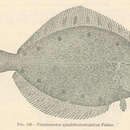fi
nimet breadcrumb-navigoinnissa


Alaska plaice (Pleuronectes quadrituberculatus) is a saltwater fish that live in the North Pacific Ocean. Alaska plaice are right-eye flounders which live on the sandy bottoms of the continental shelf, up to 600 metres deep. Their geographic range is from the Gulf of Alaska in the east, to the Chukchi Sea in the north, to the Sea of Japan in the west. Alaska plaice feed mostly on polychaetes, but also eat amphipods and echiurans.
Most commercial fisheries do not target Alaska plaice, and bycatch by commercial trawlers targeting other groundfish is the sole source of significant harvest of this species. Large schools of Alaska plaice are commonly associated with schools of Yellowfin sole, and bycatch rates can reach relatively high levels. The 2005 total allowable catch in the Bering Sea and Aleutian Islands management area (BSAI) was reached before the end of May of that year.
Alaska plaice can live for up to 30 years, and grow to 60 centimetres (24 inches) long, but most that get caught are only seven or eight years old, and about 30 cm (12 in). They are brown on the eyed side and typically pale to bright yellow on the blind side. Five to seven small boney cones are found on the head on the eyed side.
Alaska plaice (Pleuronectes quadrituberculatus) is a saltwater fish that live in the North Pacific Ocean. Alaska plaice are right-eye flounders which live on the sandy bottoms of the continental shelf, up to 600 metres deep. Their geographic range is from the Gulf of Alaska in the east, to the Chukchi Sea in the north, to the Sea of Japan in the west. Alaska plaice feed mostly on polychaetes, but also eat amphipods and echiurans.
Most commercial fisheries do not target Alaska plaice, and bycatch by commercial trawlers targeting other groundfish is the sole source of significant harvest of this species. Large schools of Alaska plaice are commonly associated with schools of Yellowfin sole, and bycatch rates can reach relatively high levels. The 2005 total allowable catch in the Bering Sea and Aleutian Islands management area (BSAI) was reached before the end of May of that year.
Alaska plaice can live for up to 30 years, and grow to 60 centimetres (24 inches) long, but most that get caught are only seven or eight years old, and about 30 cm (12 in). They are brown on the eyed side and typically pale to bright yellow on the blind side. Five to seven small boney cones are found on the head on the eyed side.
Pleuronectes quadrituberculatus Pleuronectes generoko animalia da. Arrainen barruko Pleuronectidae familian sailkatzen da.
Pleuronectes quadrituberculatus Pleuronectes generoko animalia da. Arrainen barruko Pleuronectidae familian sailkatzen da.
Pleuronectes quadrituberculatus Pallas, 1814 é un peixe teleósteo da orde dos pleuronectiformes, familia dos pleuronéctidos e subfamilia dos pleuronectinos,[1] unha das tres que integran actualmente o xénero Pleuronectes,[2] coñecida en galego como solla de Alasca.[3]
É un peixe plano de até 87 cm de lonxitude, mariño, demersal, que habita en augas da plataforma continental en fondos areosos de até os 600 metros de profundidade, no norte do océano Pacífico, desde o golfo de Alaska polo leste, o mar de Chukchi polo norte, até o mar do Xapón polo oeste.
Como todos os peixes da familia dos pleuronéctidos, ten o corpo aplanado, asimétrico, e os dous ollos situados no mesmo lado, na cara pigmentada.
A solla de Alasca é obxecto dunha importante pesca comercial.
A especie foi descrita en 1814 polo naturalista alemán Peter Simon Pallas, que o bautizou co nome aínda hoxe válido Pleuronectes quadrituberculatus.[1]
Ademais de por este nome, a especie coñécese tamén polo sinónimo Pleuronectes pallasii Steindachner, 1879.[1]
O nome específico, quadrituberculatus, está formado polo elemento prefixo latino quadri-, derivado de quattŭor, "catro", e o adxactivo do latín científico tuberculatus, -a -um, derivado do latín clásico tubercŭlum, diminutivo de tuber, "tumor", "vulto".
Literalmente: "de catro tubérculos".
A solla de Alasca pode alcanzar até 87 cm de lonxitude,[4] e os 3,5 kg de peso,[5] aínda que o tamaño medio dos espécimes apañados ronda os 36 cm.[5]
A aleta dorsal orixínase á altura do ollo superior, e ten de 63 a 74 raios. A anal, máis curta, está sustentada por de 47 a 55 raios. Ambas as dúas, pola parte posterior, chegan até o pedúnculo caudal.[6]
Presenta cinco prominencias no bordo postocular.[7]
É un peixe mariño, demersal, que vive en augas da plataforma continental, en fondos areosos de até os 600 metros de profundidade, no norte do océano Pacífico, entre os 65° N e os 48° N, desde o golfo de Alaska polo leste, o mar de Chukchi polo norte, até o mar do Xapón polo oeste.[6]
A dieta das sollas de Alasca adultas está constituída por organismos bentónicos, sobre todo por crustáceos anfípodos e vermes poliquetos.[8]
Pleuronectes quadrituberculatus captúrase nas zonas de pesca 61 e 67 (Pacífico noroeste e nordeste, respectivamente).[3]
Pleuronectes quadrituberculatus Pallas, 1814 é un peixe teleósteo da orde dos pleuronectiformes, familia dos pleuronéctidos e subfamilia dos pleuronectinos, unha das tres que integran actualmente o xénero Pleuronectes, coñecida en galego como solla de Alasca.
É un peixe plano de até 87 cm de lonxitude, mariño, demersal, que habita en augas da plataforma continental en fondos areosos de até os 600 metros de profundidade, no norte do océano Pacífico, desde o golfo de Alaska polo leste, o mar de Chukchi polo norte, até o mar do Xapón polo oeste.
Como todos os peixes da familia dos pleuronéctidos, ten o corpo aplanado, asimétrico, e os dous ollos situados no mesmo lado, na cara pigmentada.
A solla de Alasca é obxecto dunha importante pesca comercial.
Pleuronectes quadrituberculatus is een straalvinnige vissensoort uit de familie van schollen (Pleuronectidae).[1] De wetenschappelijke naam van de soort is voor het eerst geldig gepubliceerd in 1814 door Pallas.
Bronnen, noten en/of referenties黃腹鰈為輻鰭魚綱鰈形目鰈亞目鰈科的其中一種,為溫帶海水魚,分布於北太平洋楚克奇海至阿拉斯加東南部海域,棲息深度0-600公尺,體長可達62公分,棲息在底層水域,以多毛類及片腳類為食,生活習性不明,可作為食用魚。
黃腹鰈為輻鰭魚綱鰈形目鰈亞目鰈科的其中一種,為溫帶海水魚,分布於北太平洋楚克奇海至阿拉斯加東南部海域,棲息深度0-600公尺,體長可達62公分,棲息在底層水域,以多毛類及片腳類為食,生活習性不明,可作為食用魚。